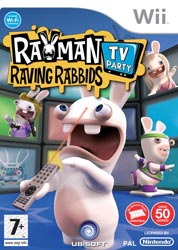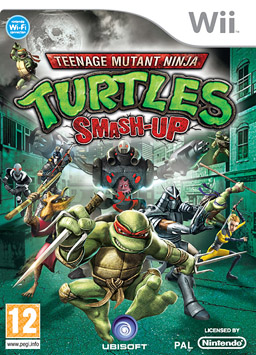
Rayman Raving Rabbids is a 2006 party video game developed and published by Ubisoft. The game is a spinoff in the Rayman series. The game consists of 75 minigames. The game was released for the PlayStation 2, Wii, Xbox 360, and Microsoft Windows systems, with a different version released for Game Boy Advance, Nintendo DS and mobile phones. Versions for GameCube, Xbox, PlayStation 3, and PlayStation Portable were planned, but were later cancelled.

Animal Crossing: City Folk, released as Animal Crossing: Let's Go to the City in PAL territories, is a 2008 social simulation video game developed and published by Nintendo for the Wii console and the third game in the Animal Crossing series. It is also one of the first titles that was re-released as a part of the Nintendo Selects collection in 2011.

Rayman Raving Rabbids is a 2006 platform video game published and developed by Ubisoft for the Game Boy Advance and Nintendo DS handheld video game consoles. It was also released on the Wii, PlayStation 2, and Xbox 360 video game consoles, as well as the PC. Unlike these versions which focus on mini-games, the handheld versions are more similar to traditional Rayman platformers.

TMNT is an action video game featuring the Teenage Mutant Ninja Turtles. It was developed by Ubisoft Montreal and published by Ubisoft for Xbox 360, Wii, PlayStation 2, GameCube, Nintendo DS, and PlayStation Portable, as well as for Microsoft Windows on March 20, 2007. It is based on the 2007 film of the same name. Versions of the game for the original Xbox and PlayStation 3 were also planned but cancelled.

Rayman Raving Rabbids 2 is a party video game developed and published by Ubisoft. The sequel to Rayman Raving Rabbids and the second installment of the Raving Rabbids spin-off franchise, it was released for the Wii and Nintendo DS platforms worldwide in 2007. It follows the Rabbids' attempt to invade Earth, with their headquarters set up near a local shopping mall. Players have the option to play as a Rabbid or as Rayman, who has disguised himself as a Rabbid to infiltrate their plans. This is the first Rayman game to have an E10+ rating by the ESRB, a greater emphasis on simultaneous multiplayer gameplay compared to the original game, and online leaderboards. It was followed by Rayman Raving Rabbids: TV Party in 2008.

MySims Party is a video game developed and published by Electronic Arts as a spinoff to Maxis' The Sims franchise for the Nintendo DS and Wii in 2009. It is the third game in the MySims series. It consists of 50+ mini-games which can be played with up to 4 players. The game was released on March 10, 2009, in North America.

Rayman Raving Rabbids: TV Party is a party video game developed and published by Ubisoft in 2008 and is the third and final installment in the original Rayman Raving Rabbids' trilogy.

MySims Racing is a go-kart-car racing game developed by Artificial Mind & Movement and published by Electronic Arts as part of the MySims series, a spin-off from its trademark The Sims series of games. The title was released in June 2009 for the Nintendo DS and Wii.

Teenage Mutant Ninja Turtles: Smash-Up is a 2.5D fighting game for the Wii and PlayStation 2 video game consoles featuring characters from the Teenage Mutant Ninja Turtles franchise. It was developed by Game Arts in cooperation with Mirage Studios, and released by Ubisoft in September 2009 in celebration of the TMNT franchise's 25th anniversary.

Mario & Sonic at the Olympic Winter Games is a 2009 sports and party game developed by Sega. Like its predecessor, it was published by Nintendo for Japan and Korea and by Sega in the Western world. The game is officially licensed by the International Olympic Committee (IOC) through exclusive license International Sports Multimedia. The game is the third official crossover title to feature characters from both Mario and Sonic's respective universes, the first and second being the game's predecessor Mario & Sonic at the Olympic Games and Super Smash Bros. Brawl respectively. It was released on the Wii and the Nintendo DS in October 2009, and is the first official video game of the 2010 Winter Olympic Games.

Mario is a Japanese multimedia franchise created by Japanese game designer Shigeru Miyamoto for video game company Nintendo which produces and publishes its installments. Starring the titular Italian plumber Mario, it is primarily a video game franchise, but has extended to other forms of media, including television series, comic books, a 1993 feature film, a 2023 animated film and theme park attractions. The series' first installment was 1983's Mario Bros., although Mario had made his first appearance in 1981's arcade game Donkey Kong, and had already been featured in several games of the Donkey Kong and Game & Watch series. The Mario games have been developed by a wide variety of developers including Nintendo, Hudson Soft, and AlphaDream. Mario games have been released almost exclusively for Nintendo's various video game consoles and handhelds, from the third generation onward.

Prince of Persia: The Forgotten Sands refers to a group of 2010 action-adventure video games developed and published by Ubisoft, with each version handled by different internal teams. The main version was developed for PlayStation 3, Xbox 360 and Windows; other versions were developed for Nintendo DS, PlayStation Portable, mobile and web browsers, and a notable version for the Wii. It forms part of the Prince of Persia series, and is set within the continuity of Prince of Persia: The Sands of Time (2003).

Just Dance is a 2009 music rhythm game developed by Ubisoft Milan and Ubisoft Paris and published by Ubisoft as the first main installment of the Just Dance series. The game was released exclusively for the Wii on November 17, 2009, in North America, November 26, 2009, in Australia, and November 27, 2009, in Europe.

Academy of Champions: Soccer is a soccer video game developed by Ubisoft Vancouver and published by Ubisoft for the Wii.

Michael Jackson: The Experience is a music video game based on Michael Jackson's songs. It was developed and published by Ubisoft, and was released on 23 November 2010 in North America, 25 November 2010 in Australia and 26 November 2010 in Europe for the Nintendo DS, PlayStation Portable, and Wii. It was also released on 12 April 2011 in North America, 14 April 2011 in Australia and 15 April 2011 in Europe for PlayStation 3's PlayStation Move and Xbox 360's Kinect. The Japanese release on 8 December 2011 only revised the PlayStation 3, Xbox 360, and Wii consoles. The game features many of Michael Jackson's hits, such as "Bad", "Thriller", "Beat It", "Billie Jean", "Smooth Criminal", "Black or White", "The Way You Make Me Feel", etc. However, some songs like "Man in the Mirror" and "P.Y.T. " are excluded. Initial launches of the game included a limited edition replica of Jackson's sequined glove. It was later released for the Nintendo 3DS on 7 November 2011 in North America and 11 November 2011 in Europe, for iPhone and iPad on 7 December 2011 in North America and for PlayStation Vita on 15 February 2012 in North America, 22 February 2012 in Europe and 23 February 2012 in Australia. It was announced that the game would be released on Mac OS X, and iPad 2. The game sold 2 million units in two months, not including Japanese sales, making it one of the best-selling Wii title games.

Raving Rabbids: Travel in Time is a party video game developed and published by Ubisoft for the Wii. It was released in North America on November 21, 2010, in Europe on November 26, 2010, in Australia on November 25, 2010 and in Japan on January 27, 2011. It is the fifth installment in the Rabbids series and, unlike the previous entry, Rabbids Go Home, it returns to the party game genre.

ZombiU is a first-person survival horror video game developed by Ubisoft Montpellier and published by Ubisoft. It was released for the Wii U as one of its launch games in November 2012. In the game, the player assumes control of a human survivor amid a 2012 zombie apocalypse. Featuring a permadeath system, it uses the Wii U GamePad extensively to scan the environment and maintain the survivor's inventory. The game was released under the name Zombi for PlayStation 4, Windows, and Xbox One in 2015. The port, handled by Straight Right, adds new melee weapons and removes the multiplayer feature.

Rabbids Land is a Wii U game that was announced by Ubisoft at E3 2012. It is the seventh console installment of the Rabbids series. The game was later ported to Japan for release on June 6, 2013. It received mixed reviews, with critics praising several mini-games but criticizing its board game play style.

Mario + Rabbids Kingdom Battle is an action-adventure turn-based tactics video game developed by Ubisoft Milan and Ubisoft Paris and published by Ubisoft for the Nintendo Switch video game console. The game is a crossover between Nintendo's Mario and Ubisoft's Rabbids franchise. In Kingdom Battle, the story follows Mario, his friends, and a group of Rabbids who try to save the Mushroom Kingdom from invading Rabbids that accidentally misused a powerful invention and began to wreak havoc.



















